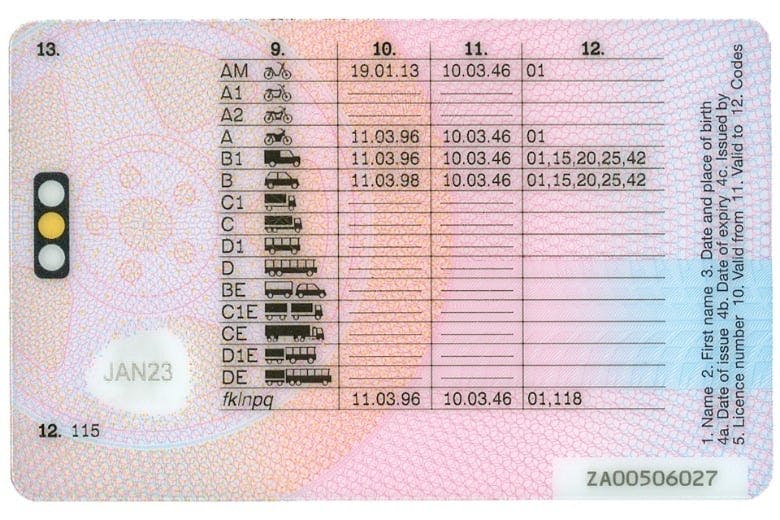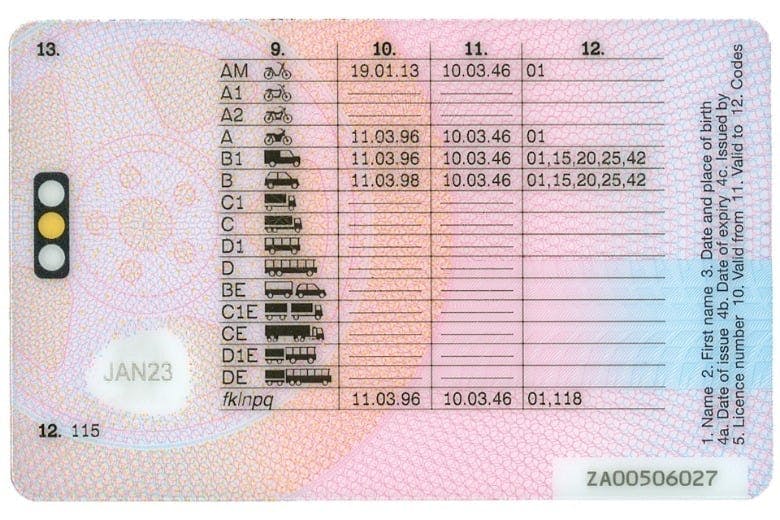
If you've had your licence for any period of time, you'll surely be familiar with what's on the front of it. After all, this is what you'll have to show as a means of ID. However, even drivers who've been on the road for years are unlikely to have paid much attention to the reverse side of their licence. Look closely, however, and you may well notice certain numbers cropping up. These aren't random. In fact, they represent key information about you as a driver—and, in certain situations, ignoring them could land you with a hefty fine.
We're going to look at what these driving licence codes are, why they're so important and the repercussions you could face if you don't adhere to them.
What are driving licence codes?

You'll undoubtedly be familiar with the information that's listed on the front of your full driving licence—from your name to your address to the date your licence was issued. It's even got that #instaperfect picture of you on the front that somehow doesn't look as good in black and white. What you probably won't have glanced twice at, however, is the back of your licence.
Much like the front of your licence, the reverse side holds a range of important information that you should be aware of. If you turn it around, you'll be able to see a small table with numbered columns. Here's what each column represents:
- Column 9 lists the type of vehicles that you might be entitled to drive
- Column 10 shows the earliest date from which a driving category is valid from
- Column 11 shows the date at which your driving category is no longer valid
- Column 12 includes driving licence codes that show what restrictions are in place
The driving licence codes found in column 12 relate to certain rules or restrictions that are in place for the vehicle you drive and how your driving in general. These codes range from health-related conditions (needing to wear glasses or contact lenses) to stipulations for the vehicle you're driving (a limited number of seats or a maximum weight) to vehicle modifications (modified braking systems or clutch).
You can check out the full list of driving licence codes in the handy table below!
Driving Licence Codes
01 - Eyesight correction (glasses or contact lenses)
02 - Hearing/communication aid
10 - Modified transmission
15 - Modified clutch
20 - Modified braking systems
25 - Modified accelerator systems
30 - Combined braking and accelerator systems (for licences issues before 28 November 2016)
31 - Pedal adaptations and pedal safeguards
32 - Combined service brake and accelerator systems
33 - Combined service brake, accelerator and steering systems
35 - Modified control layouts
40 - Modified steering
42 - Modified rear-view mirror(s)
43 - Modified driving seats
44 - Modifications to motorcycles
(1) Single operated brake
(2) Adapted front wheel brake
(3) Adapted rear wheel brake
(4) Adapted accelerator
(5) (Adjusted) manual transmission and manual clutch
(6) (Adjusted) rear-view mirror(s)
(7) (Adjusted) commands (direction indicators, braking light, etc.)
(8) Seat heigh allowing the driver, in sitting position, to have two feet on the surface at the same time and balance the motorcycle during stopping and standing
(11) Adapted foot rest
(12) Adapted hand grip
45 - Motorcycle only with sidecar
46 - Tricycles only (for licences issued before 29 June 2014)
70 - Exchange of licence
71 - Duplicate of licence
78 - Restricted to vehicles with automatic transmission
79 - Restricted to vehicles in conformity with the specifications stated in brackets
(02) Restricted to category AM vehicles of the three-weel or light quadricycle type
(03) Restricted to tricycles
96 - Allowed to drive a vehicle and trailer where the trailer weighs at least 750kg, and the combined weight of the vehicle and trailer is between 3,500kg and 4,250kg.
97 - Not authorised to drive category C1 which falls within the scope of Council Regulations (EC) NO 561/2006 on tachographs in road transport
101 - Not for hire or reward (aka, you're not allowed to make a profit)
102 - Drawbar trailers only
105 - Vehicle not more than 5.5m long
106 - Restricted to vehicles with automatic transmissions
107 - Not more than 8,250kg
108 - Subject to minimum age requirements
110 - Limited to invalid carriages/transporting persons with restricted mobility
111 - Limited to 16 passenger seats
113 - Limited to 16 passenger seats except for automatics
114 - With any special controls required for safe driving
115 - Organ donor
118 - Start date is for earliest entitlement
119 - Weight limit for vehicle does not apply
121 - Restricted to conditions specified in the Secretary of State's notice
122 - Valid on successful completion: compulsory basic training (CBT)
123 - Limited to not more than 5.5m long except for automatics
124 - Limited to drawbar trailers only except for automatics
125 - Tricycle
How does the DVLA know which codes I need on my licence?
Remember when you had to apply for your provisional licence? Part of your application involved you filling out a medical questionnaire and disclosing any medical conditions that could affect your driving. The DVLA uses this information—along with category-specific stipulations—to create the driving licence codes on the back of your card. If you declared, for example, that you need a hearing or communication aid, you'll have a 02 code on your licence. Your licence will even have a code if you told the DVLA that you're on the organ donor registry!
It's important that you keep your driving licence updated—whether it's a change in your medical condition(s), address or marital status. If you don't, the DVLA could fine you up to £1,000!
What if I just ignore my driving licence codes?
Though these driving licence codes might seem easy to ignore, it's important that you not only know which codes apply to you, but also that you adhere to the regulations they represent. If you're found to be violating these conditions, you could face serious consequences.
For starters, though roadside punishment is rare for driving licence codes, you could end up with a £100 on-the-spot fine by police for certain breaches, e.g., if you're not wearing glasses or contact lenses despite having a 01 code on your licence. You could also end up with 3 to 6 penalty points for “driving otherwise than in accordance with a licence” and an additional fine worth 50% of your weekly salary (capped at £1,000).
Even though the chances of you getting caught ignoring your driving licence codes are incredibly slim, do you really want to risk a fine or getting points on your licence? All you've got to do is glance at the back of your licence and see if there are any particular restrictions in place. It's not rocket science!
Subscribe for driving advice, offers & more
We'd love to let you know about our courses, news and offers via email. You may unsubscribe at any time.
Star Genie Limited trading as PassMeFast. Company number 10093359
Copyright © 2024 owned by Star Genie Limited
PassMeFast, Blue Tower, MediaCityUK, Salford, M50 2ST

